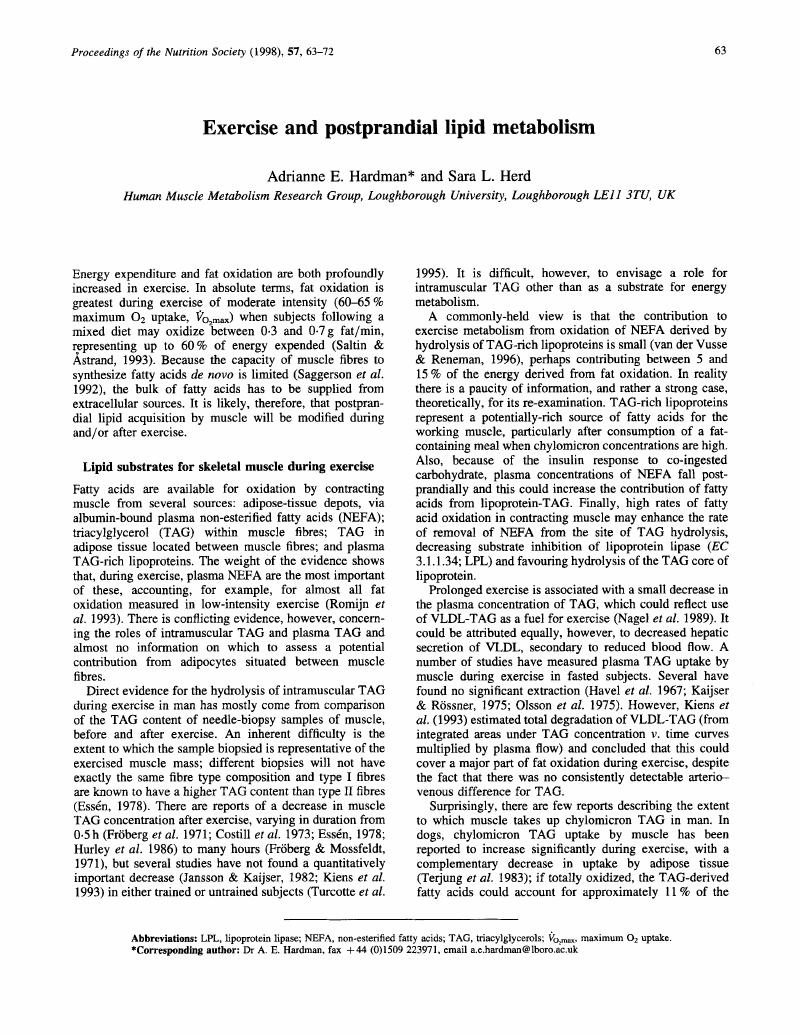Crossref Citations
This article has been cited by the following publications. This list is generated based on data provided by Crossref.
Ashworth, Ann
1998.
Nutrition interventions to reduce diarrhoea morbidity and mortality.
Proceedings of the Nutrition Society,
Vol. 57,
Issue. 01,
p.
167.
Gibney, M. J.
1999.
Strategies for altering population intakes of fats and fatty acids.
Proceedings of the Nutrition Society,
Vol. 58,
Issue. 1,
p.
189.
Suter, Paolo M.
Gerritsen-Zehnder, Margreta
Häsler, Erik
Gürtler, Magdalen
Vetter, Wilhelm
and
Hänseler, Edgar
2001.
Effect of Alcohol on Postprandial Lipemia with and without Preprandial Exercise.
Journal of the American College of Nutrition,
Vol. 20,
Issue. 1,
p.
58.
Décombaz, Jacques
Schmitt, Beat
Ith, Michael
Decarli, Bernard
Diem, Peter
Kreis, Roland
Hoppeler, Hans
and
Boesch, Chris
2001.
Postexercise fat intake repletes intramyocellular lipids but no faster in trained than in sedentary subjects.
American Journal of Physiology-Regulatory, Integrative and Comparative Physiology,
Vol. 281,
Issue. 3,
p.
R760.
Shono, Naoko
Urata, Hidenori
Saltin, Bengt
Mizuno, Masao
Harada, Taeko
Shindo, Munehiro
and
Tanaka, Hiroaki
2002.
Effects of Low Intensity Aerobic Training on Skeletal Muscle Capillary and Blood Lipoprotein Profiles.
Journal of Atherosclerosis and Thrombosis,
Vol. 9,
Issue. 1,
p.
78.
Schoppen, Stefanie
Pérez-Granados, Ana M.
Vaquero, M. Pilar
Carbajal, Ángeles
Oubiña, Pilar
Sánchez-Muniz, Francisco J.
and
Gómez-Gerique, Juan A.
2004.
A Sodium-Rich Carbonated Mineral Water Reduces Cardiovascular Risk in Postmenopausal Women.
The Journal of Nutrition,
Vol. 134,
Issue. 5,
p.
1058.
Suter, P.M.
2005.
Atherosclerosis: Diet and Drugs.
Vol. 170,
Issue. ,
p.
231.
Schoppen, Stefanie
Pérez-Granados, Ana M.
Carbajal, Ángeles
Sarriá, Beatriz
Sánchez-Muniz, Francisco J.
Gómez-Gerique, Juan A.
and
Vaquero, M. Pilar
2005.
Sodium bicarbonated mineral water decreases postprandial lipaemia in postmenopausal women compared to a low mineral water.
British Journal of Nutrition,
Vol. 94,
Issue. 4,
p.
582.
Tobin, L. W. L.
Kiens, B.
and
Galbo, H.
2007.
The effect of exercise on postprandial lipidemia in type 2 diabetic patients.
European Journal of Applied Physiology,
Vol. 102,
Issue. 3,
p.
361.
Nash, Mark
and
Mendez, Armando
2009.
Nonfasting Lipemia and Inflammation as Cardiovascular Disease Risks After SCI.
Topics in Spinal Cord Injury Rehabilitation,
Vol. 14,
Issue. 3,
p.
15.
Torres-Durán, Patricia Victoria
Ferreira-Hermosillo, Aldo
Ramos-Jiménez, Arnulfo
Hernández-Torres, Rosa Patricia
and
Juárez-Oropeza, Marco Antonio
2012.
Effect ofSpirulina maximaon Postprandial Lipemia in Young Runners: A Preliminary Report.
Journal of Medicinal Food,
Vol. 15,
Issue. 8,
p.
753.
Morris, Ciara
O’Grada, Colm M.
Ryan, Miriam F.
Gibney, Michael J.
Roche, Helen M.
Gibney, Eileen R.
and
Brennan, Lorraine
2015.
Modulation of the lipidomic profile due to a lipid challenge and fitness level: a postprandial study.
Lipids in Health and Disease,
Vol. 14,
Issue. 1,
Costa-Vieira, Daniela
Monteiro, Rosário
and
Martins, Maria João
2019.
Metabolic Syndrome Features: Is There a Modulation Role by Mineral Water Consumption? A Review.
Nutrients,
Vol. 11,
Issue. 5,
p.
1141.



